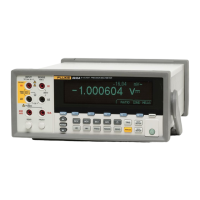Digital Multimeter
Network Primer
91
Table 35. IP Address Assignments
Class w Value Network ID Host ID
Available
Subnets
Available
Hosts
A 1 to 126 w x,y,z 126 16777214
B 128 to 191 w,x y,z 16384 65534
C 192 to 223 w,x,y z 2097151 254
The following are reserved addresses and may not be assigned to hosts:
127.0.0.0
128.0.0.0
191.255.0.0
192.0.0.0
223.255.255.0
w = 224 through 255 with x, y, and z equal to any value
Most IP subnets have Class B or C network IDs because there are quite a few of these
available. You may be able to get a Class A Net ID, but there are so few of these
available (only 126 world-wide) that they are rarely issued and most are already assigned.
Most companies can get one or more Class C blocks, which means that there is a limit of
254 hosts per network subnet.
The TCP/IP software separates the network ID portion of the IP address from the host ID
portion using the user-assigned Subnet Mask. This mask looks like an IP address, but has
a bit set in each bit position of the portion of the IP address that is in the network ID
portion. For example, the subnet mask 255.255.255.0 sets the network ID portion to be
the higher order 24 bits of the IP address (a class C address). Using the subnet mask, the
TCP/IP software is able to detect if a destination address is in the local subnet or if the
packet must be sent to another subnet through a Router or Gateway.
Networks are segmented by use of an active device called a router (gateways and hubs
sometimes have router capabilities.) When a host on one subnet wants to send a message
to a host on another subnet (the Net ID sections of the IP source and destination are
different), the router is used to deliver the packet to the other network subnet.
Each Meter is shipped with a default IP address of 129.196.136.131. This is a Class C
network ID assigned to the Fluke Corporation, so it is highly unlikely that it will overlap
with a network ID in use at your company. However, if you want to attach a Meter to an
existing network, you should check with your Network Administrator before using the
default IP address or assigning a new IP address to a Meter or PC.
If your network contains more than one subnet, and you want to communicate with a
Meter in another subnet, you need to set the default gateway address in both the host PC
and the Meter to the address of the local router. The TCI/IP stack will detect that the
destination address for a packet is in a different subnet (via the subnet mask) and send the
packet to the default gateway address where the router will route it to the proper subnet.
For example, if you have three Meters, and a single PC, you could set the following IP
addresses:
8845/8846 Series #1 198.178.246.1
8845/8846 Series #2 198.178.246.2
8845/8846 Series #3 198.178.246.3
Host PC 198.178.246.101

